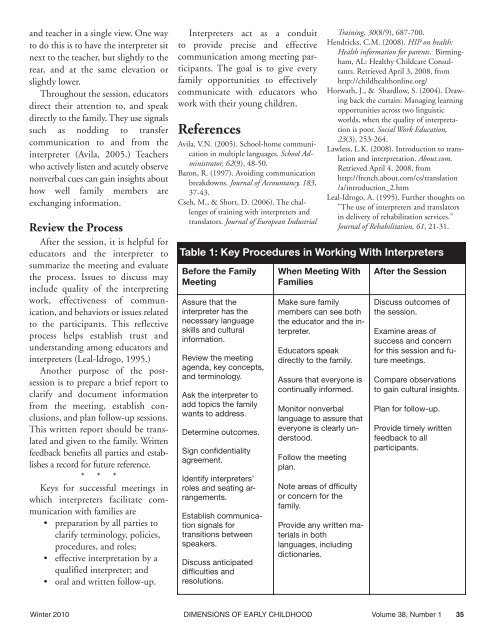90223 Dimensions Winter 10:Layout 1 - Southern Early Childhood ...
90223 Dimensions Winter 10:Layout 1 - Southern Early Childhood ...
90223 Dimensions Winter 10:Layout 1 - Southern Early Childhood ...
Create successful ePaper yourself
Turn your PDF publications into a flip-book with our unique Google optimized e-Paper software.
and teacher in a single view. One way<br />
to do this is to have the interpreter sit<br />
next to the teacher, but slightly to the<br />
rear, and at the same elevation or<br />
slightly lower.<br />
Throughout the session, educators<br />
direct their attention to, and speak<br />
directly to the family. They use signals<br />
such as nodding to transfer<br />
communication to and from the<br />
interpreter (Avila, 2005.) Teachers<br />
who actively listen and acutely observe<br />
nonverbal cues can gain insights about<br />
how well family members are<br />
exchanging information.<br />
Review the Process<br />
After the session, it is helpful for<br />
educators and the interpreter to<br />
summarize the meeting and evaluate<br />
the process. Issues to discuss may<br />
include quality of the interpreting<br />
work, effectiveness of communication,<br />
and behaviors or issues related<br />
to the participants. This reflective<br />
process helps establish trust and<br />
understanding among educators and<br />
interpreters (Leal-Idrogo, 1995.)<br />
Another purpose of the postsession<br />
is to prepare a brief report to<br />
clarify and document information<br />
from the meeting, establish conclusions,<br />
and plan follow-up sessions.<br />
This written report should be translated<br />
and given to the family. Written<br />
feedback benefits all parties and establishes<br />
a record for future reference.<br />
* * *<br />
Keys for successful meetings in<br />
which interpreters facilitate communication<br />
with families are<br />
• preparation by all parties to<br />
clarify terminology, policies,<br />
procedures, and roles;<br />
• effective interpretation by a<br />
qualified interpreter; and<br />
• oral and written follow-up.<br />
Interpreters act as a conduit<br />
to provide precise and effective<br />
communication among meeting participants.<br />
The goal is to give every<br />
family opportunities to effectively<br />
communicate with educators who<br />
work with their young children.<br />
References<br />
Avila, V.N. (2005). School-home communication<br />
in multiple languages. School Administrator,<br />
62(9), 48-50.<br />
Baron, R. (1997). Avoiding communication<br />
breakdowns. Journal of Accountancy, 183,<br />
37-43.<br />
Cseh, M., & Short, D. (2006). The challenges<br />
of training with interpreters and<br />
translators. Journal of European Industrial<br />
Training, 30(8/9), 687-700.<br />
Hendricks, C.M. (2008). HIP on health:<br />
Health information for parents. Birmingham,<br />
AL: Healthy Childcare Consultants.<br />
Retrieved April 3, 2008, from<br />
http://childhealthonline.org/<br />
Horwath, J., & Shardlow, S. (2004). Drawing<br />
back the curtain: Managing learning<br />
opportunities across two linguistic<br />
worlds, when the quality of interpretation<br />
is poor. Social Work Education,<br />
23(3), 253-264.<br />
Lawless, L.K. (2008). Introduction to translation<br />
and interpretation. About.com.<br />
Retrieved April 4, 2008, from<br />
http://french.about.com/cs/translation<br />
/a/introduction_2.htm<br />
Leal-Idrogo, A. (1995). Further thoughts on<br />
"The use of interpreters and translators<br />
in delivery of rehabilitation services.”<br />
Journal of Rehabilitation, 61, 21-31.<br />
Table 1: Key Procedures in Working With Interpreters<br />
Before the Family<br />
Meeting<br />
Assure that the<br />
interpreter has the<br />
necessary language<br />
skills and cultural<br />
information.<br />
Review the meeting<br />
agenda, key concepts,<br />
and terminology.<br />
Ask the interpreter to<br />
add topics the family<br />
wants to address.<br />
Determine outcomes.<br />
Sign confidentiality<br />
agreement.<br />
Identify interpreters’<br />
roles and seating arrangements.<br />
Establish communication<br />
signals for<br />
transitions between<br />
speakers.<br />
Discuss anticipated<br />
difficulties and<br />
resolutions.<br />
When Meeting With<br />
Families<br />
Make sure family<br />
members can see both<br />
the educator and the interpreter.<br />
Educators speak<br />
directly to the family.<br />
Assure that everyone is<br />
continually informed.<br />
Monitor nonverbal<br />
language to assure that<br />
everyone is clearly understood.<br />
Follow the meeting<br />
plan.<br />
Note areas of dfficulty<br />
or concern for the<br />
family.<br />
Provide any written materials<br />
in both<br />
languages, including<br />
dictionaries.<br />
After the Session<br />
Discuss outcomes of<br />
the session.<br />
Examine areas of<br />
success and concern<br />
for this session and future<br />
meetings.<br />
Compare observations<br />
to gain cultural insights.<br />
Plan for follow-up.<br />
Provide timely written<br />
feedback to all<br />
participants.<br />
<strong>Winter</strong> 20<strong>10</strong> DIMENSIONS OF EARLY CHILDHOOD Volume 38, Number 1 35
















